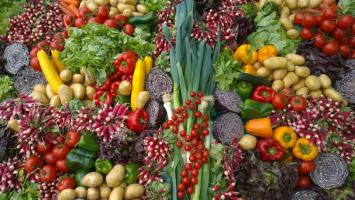
DIET & LIFESTYLE
DISCOVER HOW TO HEAL
Written by John Immel, If you're like me, you grew up with your food heaped onto a large plate all at once. Rarely do we eat meals in courses here in the United States, with the exception of a dessert after the meal. There are other exceptions: Americans eat meals in courses at a celebration like a wedding, and restaurants typically serve bread, salads, and appetizers before the main meal. For most of us, this style of eating our meals all at once allows us to eat at breakneck speed, with maximum efficiency. However, many of cultures around the world follow the course approach in their daily meal habits, and this leads to slow, enjoyable, and healthier eating. For them, food is part of daily entertainment, enjoyed slowly with conversation, because it is served in courses. We wanted to see what would happen if we started eating meals in courses. So the kids, my wife, and I gave it a try for a few weeks, and were astonished at the results. EATING IN COURSES: THE EXPERIMENTWe started the meal with fresh greens. This was followed by a light soup or vegetable dish. Then we served the main entree, which included a protein such as beans or a meat dish. Finally, the meal was followed by a dessert of a few berries, a slice of cheese, or a small truffle. We waited until everyone was finished with each course before the serving the next one. The foods we ate weren't different than our normal fare, we just served them differently.EATING IN COURSES: THE RESULTSFor one, our kids were eating more vegetables than ever. They came to dinner hungry and had to eat the salad and veggies before continuing to the main entree. Usually, the kids ate the main entree first and were too full to enjoy the vegetable side dishes. Bringing up Bebe actually told us this would happen. The book claimed that eating in courses was the secret to the varied palate of French children, and why macaroni-and-cheese-only kids simply don't exist in France. Since the kids were coming to the meal hungry, they binged on broccoli instead of rice!Second, we were all more relaxed during the meal. Waiting for everyone to finish the course opened up room for digestion and conversation. There wasn't the usual silence when the food came. We discussed and appreciated the food instead of devouring it. Instead of shoveling it all in, we savored the meal. It is so easy to start rushing while eating, especially when you are hungry. But by spacing things out, your body is forced to calm down a bit. We spent at least 30 more minutes at the table each night. And for us, this meant more relaxed family time. Even more surprising, we noticed we were eating less. I was much less hungry by the third course, and therefore, ate less of the main entree, which is typically the most calorically dense, than I normally would. The slow, drawn-out pace of the meal also meant that I was more mindful of what was going on in my stomach. As a practitioner, I try my best to do this all the time, but sometimes this goes to the wayside when I am rushed or distracted. Eating in sequential courses eliminated this issue; you have to pay more attention, by default. So, like the kids, I was filling up on vegetables instead of rice or pasta, which was good for both my health and waistline. Eating in courses was much more enjoyable than we thought, and much easier too. We made it official, and there is no going back. We are still eating this way for dinner. One day, when in a hurry, I gave my four year old her lunch - everything at once, instead of divied up. To my surprise, she protested, "But, what about the courses?!" It seems that the children also prefer eating this way, in part because it feels fancy and in part because it feels good to their bodies. EATING IN COURSES: THE RESEARCHThe general pattern for eating, worldwide, is in courses. From France[1] to Russia, Spain to China, many countries choose to serve their meals in courses for a variety of reasons. For one, eating meals in courses means eating more slowly and spending more time together as a family. If you spend 15 minutes on each course and have four courses per meal, this means you spend 40 minutes to an hour at the table. This is a far cry from the 20 minute average that most families spend eating at the dinner table in the U.S. Studies show that sitting at the table longer is correlated with lower obesity rates and higher satisfaction rates. [2] Why is eating quickly associated with weight gain in numerous studies? One reason is that eating quickly means not giving the body enough time to recognize that it's full. Typically, our brains need about 20 minutes to recognize that our stomach is full and our appetite is satisfied. So, if you are eating your meal in under 20 minutes, your body is not going to have time to realize that it has had enough. This means you are more likely to overeat. Serving meals in courses helps avoid this issue of quick eating. Instead of wolfing down the food on your plate, courses force you to slow down and pay attention to each item in the meal as it comes. According to Ayurveda, eating only one food at a time also offers many gastronomic benefits. Starting your meals with the most easy to digest items, like freshly steamed vegetables, and ending meals with heavier items, like beans or meats, is much easier on your digestive system. The more time you spend on each course, the more time your gastric juices have to process each food item, which improves digestion even more. This means a happier tummy and a happier you! HOW TO EAT IN COURSESSo, how can you incorporate this style of eating to your nightly meals? Keep it simple. Generally, we recommend the following: Start with a soup or salad, then a vegetable dish, then the entree du jour, and finish with a small dessert. Of course, there are many exceptions to this rule. In India, dal, a thin soup of lentils, is served at the end of a meal.The idea of planning and preparing four courses every night may seem daunting and unrealistic, but you don't have to change much. Serve what you would normally serve, but split it up. If you normally make rice, beans, and a vegetable for dinner, serve the vegetable first, then the rice dish, followed by the bean soup. If you are a one pot meal kind of person, whip up something easy and quick like bruschetta, a salad, or a steamed vegetable. And for dessert? End the meal with a small piece of chocolate. Eating in courses doesn't have to be fancy or complicated; all you have to do is reallocate, and at most, prepare another vegetable. Another fun idea is to serve a special meal in courses over the weekends. The Sunday family meal is still popular all across Europe to this day. Grandparents, parents, kids, and grandkids will all get together and spend the day cooking and feasting. These meals often consist of many courses and last several hours. They are an important time of bonding and reconnecting for the family, and are a fun time to swap recipes and learn from one another. So, consider starting a new tradition that involves everyone making and breaking bread together on Saturdays or Sundays! [1] https://foodtimeline.org/restaurants.html#classicfrench
READ MORE ON THIS TOPIC
BROWSE SIMILAR ARTICLES BY TOPIC

About the Author John Immel, the founder of Joyful Belly, teaches people how to have a healthy diet and lifestyle with Ayurveda biocharacteristics. His approach to Ayurveda is clinical, yet exudes an ease which many find enjoyable and insightful. John also directs Joyful Belly's School of Ayurveda, offering professional clinical training in Ayurveda for over 15 years.John's interest in Ayurveda and specialization in digestive tract pathology was inspired by a complex digestive disorder acquired from years of international travel, as well as public service work in South Asia. John's commitment to the detailed study of digestive disorders reflects his zeal to get down to the roots of the problem. His hope and belief in the capacity of each & every client to improve their quality of life is nothing short of a personal passion. John's creativity in the kitchen and delight in cooking for others comes from his family oriented upbringing. In addition to his certification in Ayurveda, John holds a bachelor's degree in mathematics from Harvard University. John enjoys sharing Ayurveda within the context of his Catholic roots, and finds Ayurveda gives him an opportunity to participate in the healing mission of the Church. Jesus expressed God's love by feeding and healing the sick. That kindness is the fundamental ministry of Ayurveda as well. Outside of work, John enjoys spending time with his wife and 7 kids, and pursuing his love of theology, philosophy, and language. STUDY AYURVEDA
Questions, Comments & Impressions of 'the secret to eating slowly'?Is there something else you'd like to know about 'the secret to eating slowly'?     (5.00 out of 5 stars) 1 rating, 22 likes (5.00 out of 5 stars) 1 rating, 22 likes     Sign in to review this article Sign in to review this article
I enjoy your articles very much thank you!
We're so glad to hear it! Thank you for your feedback.
|
Join Joyful Belly.
Want our top Ayurvedic recipes and health tips?Subscribe to our free newsletter!

 SAVE ARTICLE
SAVE ARTICLE

 On MeWe
On MeWe On Pinterest
On Pinterest On Facebook
On Facebook On Twitter
On Twitter On WhatsApp
On WhatsApp On Email
On Email


